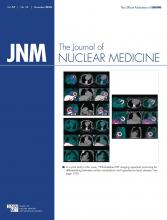Theranostics in oncology: Taïeb and colleagues provide an introduction to integrated diagnostics and therapeutics, using the radioiodine theranostic model as a template for future development of nuclear medicine approaches.
Page 1659
Optical imaging of ionizing radiation: Shaffer and colleagues review optical imaging of both radionuclide- and beam-based ionizing radiation from high-energy photons and charged particles through mechanisms including radioluminescence, Cerenkov luminescence, and scintillation.
Page 1661
18F-FDG–derived blood flow and outcomes: Doot looks at PET protocols that may enable routine predictive blood flow or 18F-FDG transport measures after neoadjuvant therapy in breast cancer and previews a related article in this issue of JNM.
Page 1667
PET/CT and cardiac infection: Gomes and colleagues detail evidence for the value of 18F-FDG PET/CT in diagnostic workups of suspected infective endocarditis or implantable cardiac electronic device–related infection and discuss a related article in this month’s JNM.
Page 1669
Predictive vs. post-SIRT 90Y dosimetry: Gnesin and colleagues evaluate agreement between the predictive dosimetry of 99mTc-MAA SPECT/CT and posttreatment dosimetry based on 90Y time-of-flight PET/CT in selective internal radiation therapy in patients with hepatocellular carcinoma.
Page 1672
G5 as radioembolization injection vehicle: Paprottka and colleagues compare the need for periinterventional on-demand analgesia when water is replaced with 5% glucose for 90Y-resin microsphere administration.
Page 1679
131I and salivary function in DTC: Klein Hesselink and colleagues prospectively assess the effect of high-activity radioiodine treatment on stimulated whole saliva flow rate and other characteristics in patients being treated with radioiodine for differentiated thyroid cancer.
Page 1685
Quantifying lung cancer heterogeneity: Grootjans and colleagues investigate the influence of respiratory motion and varying noise levels on quantification of PET imaging textural parameters in patients with non–small cell lung cancer.
Page 1692
PERCIST and SUV harmonization strategies: Quak and colleagues determine the consistency of PERCIST classification across different reconstruction algorithms in patients with cancer and whether a proprietary software tool can harmonize SUV estimation to provide consistent response classification.
Page 1699
Blood flow response in breast cancer: Humbert and colleagues use a short dynamic 18F-FDG PET acquisition to assess the prognostic relevance of tumor blood flow changes in response to chemotherapy in patients with triple-negative breast cancer.
Page 1707
PSMA PET in recurrent prostate cancer: Rauscher and colleagues compare the accuracy of 68Ga-PSMA-HBED-CC PET and morphologic imaging in the assessment of lymph node metastases in patients with biochemical recurrence of prostate cancer.
Page 1713
68Ga-PSMA PET/CT in prostate cancer: Fendler and colleagues report on the ability of 68Ga-PSMA-HBED-CC PET/CT to localize cancer in the prostate and surrounding tissue at initial diagnosis.
Page 1720
PET/CT in infective endocarditis: Granados and colleagues determine the diagnostic accuracy of 18F-FDG PET/CT in patients with suspected infective endocarditis or implantable cardiac electronic device infections.
Page 1726
18F-florbetaben PET in cardiac amyloidosis: Law and colleagues describe the feasibility of 18F-florbetaben PET imaging in the diagnosis of cardiac amyloidosis in patients with amyloid light chain and amyloid transthyretin heart disease and in controls with hypertensive disease.
Page 1733
Cerebellar Aβ plaques and florbetaben SUVR: Catafau and colleagues assess the influence of amyloid-β pathology, including neuritic plaques, diffuse plaques, and vascular deposits, on 18F-florbetaben SUV ratios using the cerebellum as a reference.
Page 1740
Human mGluR5 and novelty seeking: Leurquin-Sterk and colleagues use 18F-FPEB PET to explore associations between metabotropic glutamate receptor 5 and temperament traits in healthy adults.
Page 1746
18F-GE180 PET for neuroinflammation: Fan and colleagues report on optimal scan duration and kinetic modeling strategies for PET imaging with this 18-kDa translocator protein–targeting agent in older healthy adults.
Page 1753
Pregnancy and 18F-FDG: Zanotti-Fregonara and colleagues refine fetal dose estimates associated with 18F-FDG administration in PET imaging using realistic voxel-based phantoms.
Page 1760
Imaging lung inflammation: Scherer and Chen provide an educational overview of current and novel imaging approaches for measuring pulmonary inflammation, with a special focus on potential applications of 18F-FDG PET.
Page 1764
Vessel-targeted α-particle immunotherapy: Behling and colleagues investigate changes in tumor vascular morphology and functionality caused by 225Ac-E4G10, an antivascular therapeutic agent, in a transgenic orthotopic glioblastoma model.
Page 1771
PET/MR-guided photothermal therapy: Zhou and colleagues describe translational studies on the feasibility of photothermal therapy for ovarian cancer under the guidance of PET and MR temperature imaging using copper sulfide nanoparticles.
Page 1778
Apoptosis and inflammation: Kamkar and colleagues report on timed results assessing histologic atherosclerosis, inflammation with 18F-FDG PET, and apoptosis with 99mTc-rhAnnexin V-128 imaging in apolipoprotein E–deficient mice undergoing low-dose radiation.
Page 1784
Novel PET imaging of atherosclerosis: Kim and colleagues determine whether mannosylated human serum albumin specifically binds to the mannose receptor on macrophages and test the feasibility of 68Ga-labeled NOTA-MSA PET imaging of atherosclerotic plaques.
Page 1792
Erythropoietin in ischemia cell therapy: Garrigue and colleagues use SPECT/CT to evaluate erythropoietin priming of endothelial colony-forming cells to enhance homing to ischemic sites after cerebral artery occlusion and reperfusion in rats and explore associated protective and regenerative effects.
Page 1798
Target upregulation: Taelman and colleagues performed a screen for drugs that upregulate the somatostatin receptor subtype 2 and characterize the effects of these drugs on transcriptional, translational, and functional levels in vitro and in vivo.
Page 1805
Selective PET imaging of VEGF receptors: Meyer and colleagues report on the development of 2 first-in-class 89Zr-labeled PET tracers that enable selective imaging of vascular endothelial growth factor receptors–1 and –2.
Page 1811
PET and soluble epoxide hydrolase: Horti and colleagues detail basic and translational studies with 18F-FNDP, a PET radiotracer with potential for elucidating the role of soluble epoxide hydrolase in conditions affecting the central nervous system.
Page 1817
Multiscale texture analysis: Orlhac and colleagues investigate the relationship between PET-derived texture indices, precise tracer distribution, and biologic heterogeneity using PET, autoradiographic, and histologic images.
Page 1823
- © 2016 by the Society of Nuclear Medicine and Molecular Imaging, Inc.







